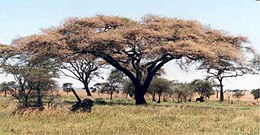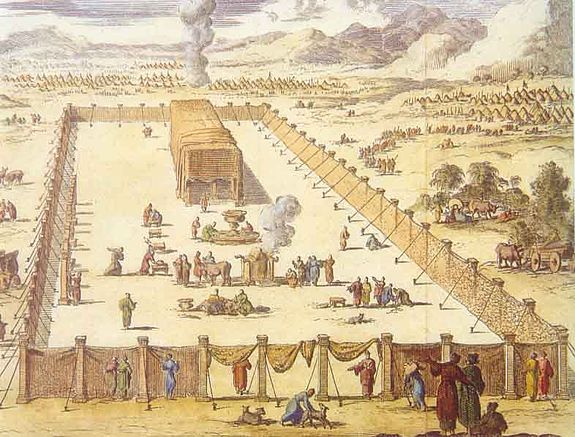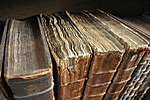→External links: move item from "texts" to the more appropriate "commentary" section |
|||
| Line 213: | Line 213: | ||
*[http://www.mechon-mamre.org/p/pt/pt0235.htm Masoretic text and 1917 JPS translation] |
*[http://www.mechon-mamre.org/p/pt/pt0235.htm Masoretic text and 1917 JPS translation] |
||
*[http://bible.ort.org/books/torahd5.asp?action=displaypage&book=2&chapter=35&verse=1&portion=22 Hear the parshah chanted] |
*[http://bible.ort.org/books/torahd5.asp?action=displaypage&book=2&chapter=35&verse=1&portion=22 Hear the parshah chanted] |
||
==Summaries== |
|||
*[http://www.patheos.com/Resources/Additional-Resources/Parshat-Vayakhel-Pekudei-and-HaChodesh.html Summary of the Vayakhel & Pekudei parshot and videos of the parshot on Patheos] |
|||
*[http://www.chabad.org/parshah/article_cdo/aid/1338/jewish/Vayakhel.htm Parasha in a Nutshell: Parasha Vayakhel] |
|||
===Commentaries=== |
===Commentaries=== |
||
Revision as of 16:07, 1 April 2010
Vayakhel, VaYakhel, Va-Yakhel, Vayak’hel, Vayak’heil, or Vayaqhel (ויקהל — Hebrew for "and he assembled,” the first word in the parshah) is the 22nd weekly Torah portion (parshah) in the annual Jewish cycle of Torah reading and the 10th in the book of Exodus. It constitutes Exodus 35:1–38:20. Jews in the Diaspora read it the 22nd Sabbath after Simchat Torah, generally in March.
The lunisolar Hebrew calendar contains up to 55 weeks, the exact number varying between 50 in common years and 54 or 55 in leap years. In leap years (for example, 2011, 2014, and 2016), parshah Vayakhel is read separately. In common years (for example, 2010, 2012, 2013, 2015, 2017, and 2018), parshah Vayakhel is combined with the next parshah, Pekudei, to help achieve the number of weekly readings needed.

Summary


Moses convoked the Israelites to build the Tabernacle. Moses started by reminding them of God’s commandment to keep the Sabbath of complete rest. (Exodus 35:1–3.) Then Moses told them to collect gifts of materials from those whose heart so moved them — gifts of gold, silver, copper, colored yarns, fine linen, goats hair, tanned ram skins, acacia wood, olive oil, spices, lapis lazuli, and other stones. (Exodus 35:4–9.) Moses invited all who were skilled to make the Tabernacle, its furnishings, and the priests’ vestments. (Exodus 35:10–19.) The Israelites brought the gifts that Moses requested. (Exodus 35:20–29.) Moses announced that God had singled out Bezalel and Oholiab to endow them with the skills needed to construct the Tabernacle. (Exodus 35:30–35.) And Moses called on them and all skilled persons to undertake the task. (Exodus 36:1–2.) The Israelites brought more than was needed, so Moses proclaimed an end to the collection. (Exodus 36:3–7.) The skilled workers fashioned the Tabernacle. (Exodus 36:8–38.) Bezalel made the ark, cover, table, menorah, incense altar, altar for sacrifices, laver, and enclosure for the Tabernacle. (Exodus 37:1–38:20.)
In inner-biblical interpretation
Exodus chapters 25–39
This is the pattern of instruction and construction of the Tabernacle and its furnishings:

| Item | Instruction | Construction | ||
|---|---|---|---|---|
| Order | Verses | Order | Verses | |
| The Sabbath | 16 | Exodus 31:12–17 | 1 | Exodus 35:1–3 |
| Contributions | 1 | Exodus 25:1–9 | 2 | Exodus 35:4–29 |
| Craftspeople | 15 | Exodus 31:1–11 | 3 | Exodus 35:30–36:7 |
| Tabernacle | 5 | Exodus 26:1–37 | 4 | Exodus 36:8–38 |
| Ark | 2 | Exodus 25:10–22 | 5 | Exodus 37:1–9 |
| Table | 3 | Exodus 25:23–30 | 6 | Exodus 37:10–16 |
| Menorah | 4 | Exodus 25:31–40 | 7 | Exodus 37:17–24 |
| Altar of Insense | 11 | Exodus 30:1–10 | 8 | Exodus 37:25–28 |
| Anointing Oil | 13 | Exodus 30:22–33 | 9 | Exodus 37:29 |
| Incense | 14 | Exodus 30:34–38 | 10 | Exodus 37:29 |
| Altar of Sacrifice | 6 | Exodus 27:1–8 | 11 | Exodus 38:1–7 |
| Laver | 12 | Exodus 30:17–21 | 12 | Exodus 38:8 |
| Tabernacle Court | 7 | Exodus 27:9–19 | 13 | Exodus 38:9–20 |
| Priestly Garments | 9 | Exodus 28:1–43 | 14 | Exodus 39:1–31 |
| Ordination Ritual | 10 | Exodus 29:1–46 | 15 | Leviticus 8:1–9:24 |
| Lamp | 8 | Exodus 27:20–21 | 16 | Numbers 8:1–4 |

In classical rabbinic interpretation
Exodus chapter 35
Rabbi Judah haNasi taught that the words “These are the words” in Exodus 35:1 referred to the 39 labors that God taught Moses at Sinai. (Babylonian Talmud Shabbat 97b.) Similarly, Rabbi Hanina bar Hama said that the labors forbidden on the Sabbath in Exodus 35:2 correspond to the 39 labors necessary to construct the Tabernacle. (Babylonian Talmud Shabbat 49b.)
Rabbi Hama bar Hanina interpreted the words “the plaited (שְּׂרָד, serad) garments for ministering in the holy place” in Exodus 35:19 to teach that but for the priestly garments described in Exodus 28 (and the atonement achieved by the garments or the priests who wore them), no remnant (שָׂרִיד, sarid) of the Jews would have survived. (Babylonian Talmud Yoma 72a–b.)
Rabbi Levi read Exodus 26:28, regarding “the middle bar in the midst of the boards, which shall pass through from end to end,” calculated that the beam must have been 32 cubits in length, and asked where the Israelites would find such a beam in the desert. Rabbi Levi deduced that the Israelites had stored up the cedar to construct the Tabernacle since the days of Jacob. Thus Exodus 35:24 reports, “And every man, with whom was found acacia-wood,” not “with whom would be found acacia-wood.” Rabbi Levi taught that the Israelites cut the trees down in Magdala of the Dyers near Tiberias and brought them with them to Egypt, and no knot or crack was found in them. (Genesis Rabbah 94:4.)
The Rabbis taught in a Baraita that the Tabernacle’s lower curtains were made of blue wool, purple wool, crimson wool, and fine linen, while the upper curtains that made the tent spread were made of goats’ hair. And they taught that the upper curtains required greater skill than the lower, for Exodus 35:25 says of the lower ones, “And all the women that were wise-hearted did spin with their hands,” while Exodus 35:26 says of the upper ones, “And all the women whose heart stirred them up in wisdom spun the goats.” It was taught in Rabbi Nehemiah's name that the hair was washed on the goats and spun while still on the goats. (Babylonian Talmud Shabbat 99a.)
Exodus chapter 36
Doing the math implied by Exodus 36:4, Exodus 38:22, Joshua 14:7, and 1 Chronicles 2:19–20, the Gemara deduced that in earlier generations, a boy of eight could father children. Exodus 38:22 reports that “Bezalel, son of Uri, son of Hur, of the tribe of Judah, made all that the Lord had commanded Moses,” when they built the Tabernacle. And 1 Chronicles 2:19–20 reports that Caleb fathered the Hur who fathered Uri who fathered Bezalel. Exodus 36:4 reports that “wise men . . . wrought all the work of the Sanctuary,” so Bezalel must have been at least 13 years old to have been a man when he worked on the Tabernacle. A Baraita taught that Moses made the Tabernacle in the first year after the Exodus, and in the second, he erected it and sent out the spies, so the Gemara deduced that Bezalel must have been at least 14 years old when Moses sent out the spies, the year after Bezalel worked on the Tabernacle. And Joshua 14:7 reports that Caleb said that he was 40 years old when Moses sent him to spy out the land. Thus, the Gemara deduced that Caleb was only 26 years older than his great-grandson Bezalel. Decucting two years for the three pregnancies needed to create the three intervening generations, the Gemara concluded that each of Caleb, Hur, and Uri must have conceived his son at the age of eight. (Babylonian Talmud Sanhedrin 69b.)
Commandments
According to Maimonides and Sefer ha-Chinuch, there is one negative commandment in the parshah:
- The court must not inflict punishment on the Sabbath. (Exodus 35:3.)
(See, e.g., Maimonides. The Commandments: Sefer Ha-Mitzvoth of Maimonides. Translated by Charles B. Chavel, 2:297. London: Soncino Press, 1967. ISBN 0-900689-71-4. Sefer HaHinnuch: The Book of [Mitzvah] Education. Translated by Charles Wengrov, 1:431–33. Jerusalem: Feldheim Pub., 1991. ISBN 0-87306-179-9.)
Haftarah

Parshah Vayakhel
When parshah Vayakhel is read alone (as it is in 2011 and 2014), the haftarah is:
- for Ashkenazi Jews: 1 Kings 7:40–50
- for Sephardi Jews: 1 Kings 7:13–26
Ashkenazi — 1 Kings 7:40–50
Both the parshah and the haftarah in 1 Kings 7 report the leader’s erection of the holy place, Moses’ building of the Tabernacle in the parshah (Exodus 35:4–38:20), and Solomon’s building of the Temple in Jerusalem in the haftarah. (1 Kings 7:40–50.) Both the parshah and the haftarah note particular metals for the holy space. (Exodus 35:5; 1 Kings 7:45, 47–50.)
Sephardi — 1 Kings 7:13–26
Both the parshah and the haftarah note the skill (chokhmah), ability (tevunah), and knowledge (da‘at), of the artisan (Bezalel in the parshah, Hiram in the haftarah) in every craft (kol mela’khah). (Exodus 35:30–31; 1 Kings 7:14.)
On Shabbat Shekalim
When Parshah Vayakhel coincides with the special Sabbath Shabbat Shekalim, (as it does in 2016), the haftarah is 2 Kings 12:1–17.
Parshah Vayakhel–Pekudei
When parshah Vayakhel is combined with parshah Pekudei, the haftarah is:
- for Ashkenazi Jews: 1 Kings 7:51–8:21
- for Sephardi Jews: 1 Kings 7:40–50

On Shabbat HaChodesh
When the parshah coincides with Shabbat HaChodesh ("Sabbath [of] the month," the special Sabbath preceding the Hebrew month of Nissan — as it does in 2010, 2013, and 2017), the haftarah is:
- for Ashkenazi Jews: Ezekiel 45:16–46:18
- for Sephardi Jews: Ezekiel 45:18–46:15
On Shabbat HaChodesh, Jews read Exodus 12:1–20, in which God commands that “This month [Nissan] shall be the beginning of months; it shall be the first month of the year” (Exodus 12:2), and in which God issued the commandments of Passover. (Exodus 12:3–20.) Similarly, the haftarah in Ezekiel 45:21–25 discusses Passover. In both the special reading and the haftarah, God instructs the Israelites to apply blood to doorposts. (Exodus 12:7; Ezekiel 45:19.)
On Shabbat Parah
When the parshah coincides with Shabbat Parah (the special Sabbath prior to Passover — as it does in 2012, 2015, and 2018), the haftarah is:
- for Ashkenazi Jews: Ezekiel 36:16–38
- for Sephardi Jews: Ezekiel 36:16–36
On Shabbat Parah, the Sabbath of the red heifer, Jews read Numbers 19:1–22, which describes the rites of purification using the red heifer (parah adumah). Similarly, the haftarah in Ezekiel 36 also describes purification. In both the special reading and the haftarah in Ezekiel 36, sprinkled water cleansed the Israelites. (Numbers 19:18; Ezekiel 36:25.)
In the liturgy
Following the Kabbalat Shabbat prayer service and prior to the Friday evening (Ma'ariv) service, Jews traditionally read rabbinic sources on the observance of the Sabbath, starting with Mishnah Shabbat 2:5. Mishnah Shabbat 2:5, in turn, interprets the laws of kindling lights in Exodus 35:3. (Reuven Hammer. Or Hadash: A Commentary on Siddur Sim Shalom for Shabbat and Festivals, 25. New York: The Rabbinical Assembly, 2003. ISBN 0-916219-20-8.)
Further reading
The parshah has parallels or is discussed in these sources:
Ancient
- The Ba‘lu Myth. Ugarit, 2nd millennium B.C.E. In The Context of Scripture, Volume I: Canonical Compositions from the Biblical World, 260–61. Edited by William W. Hallo. Pilgrim Press, 1997. ISBN 9004106189. (building of a palace for Ba'al).

Biblical
- Psalms 26:6 (washing, altar); 51:16–19 (sacrifices); 80:2 (cherubim); 84:2–3, 11 (Tabernacle, courts); 92:14 (courts); 96:6 (God's sanctuary); 100:4 (court of the Tabernacle); 134:2 (God's sanctuary); 141:2 (incense); 150:1 (God's sanctuary).
Early nonrabbinic
- Philo. Allegorical Interpretation 3:33:101; On the Migration of Abraham 17:97–98. Alexandria, Egypt, early 1st Century C.E.. Reprinted in, e.g., The Works of Philo: Complete and Unabridged, New Updated Edition. Translated by Charles Duke Yonge, 61, 262. Peabody, Mass.: Hendrickson Pub., 1993. ISBN 0-943575-93-1.

- Josephus, Antiquities of the Jews 3:6:1–10:1. Circa 93–94. Reprinted in, e.g., The Works of Josephus: Complete and Unabridged, New Updated Edition. Translated by William Whiston, 85–95. Peabody, Mass.: Hendrickson Pub., 1987. ISBN 0-913573-86-8.
Classical rabbinic
- Mekhilta According to Rabbi Ishmael 82:1. Land of Israel, late 4th Century. Reprinted in, e.g., Mekhilta According to Rabbi Ishmael. Translated by Jacob Neusner, 2:258–62. Atlanta: Scholars Press, 1988. ISBN 1-55540-237-2.
- Genesis Rabbah 94:4. Land of Israel, 5th Century. Reprinted in, e.g., Midrash Rabbah: Genesis. Translated by H. Freedman and Maurice Simon, 2:871. London: Soncino Press, 1939. ISBN 0-900689-38-2.

- Babylonian Talmud: Shabbat 20a, 49b, 70a, 74b, 96b; Eruvin 2b; Yoma 66b, 72b, 75a; Beitzah 4b; Rosh Hashanah 34a; Chagigah 10a–b; Yevamot 6b–7a, 33b; Sotah 3a; Kiddushin 37a; Bava Kamma 2a, 54a, 71a; Sanhedrin 35b, 69b; Makkot 21b; Shevuot 26b; Avodah Zarah 12b, 24a; Zevachim 59b; Bekhorot 41a. Babylonia, 6th Century. Reprinted in, e.g., Talmud Bavli. Edited by Yisroel Simcha Schorr, Chaim Malinowitz, and Mordechai Marcus, 72 vols. Brooklyn: Mesorah Pubs., 2006.
Medieval
- Exodus Rabbah 48:1–50:5. 10th Century. Reprinted in, e.g., Midrash Rabbah: Exodus. Translated by S. M. Lehrman, 3:546–61. London: Soncino Press, 1939. ISBN 0-900689-38-2.
- Solomon ibn Gabirol. A Crown for the King, 9:105–06. Spain, 11th Century. Translated by David R. Slavitt, 14–15. New York: Oxford University Press, 1998. ISBN 0-19-511962-2.

- Rashi. Commentary. Exodus 35–38. Troyes, France, late 11th Century. Reprinted in, e.g., Rashi. The Torah: With Rashi's Commentary Translated, Annotated, and Elucidated. Translated and annotated by Yisrael Isser Zvi Herczeg, 2:487–505. Brooklyn: Mesorah Publications, 1994. ISBN 0-89906-027-7.
- Zohar 2:194b–220a. Spain, late 13th Century.
Modern
- Thomas Hobbes. Leviathan, 3:34. England, 1651. Reprint edited by C. B. Macpherson, 431. Harmondsworth, England: Penguin Classics, 1982. ISBN 0140431950.
- Edward Taylor. “18. Meditation. Heb. 13.10. Wee Have an Altar.” In Preliminary Meditations: First Series. Cambridge, Mass.: Early 18th Century. In Harold Bloom. American Religious Poems, 21–22. New York: Library of America, 2006. ISBN 978-1-931082-74-7.
- Abraham Joshua Heschel. The Sabbath. New York: Farrar Straus Giroux, 1951. Reprinted 2005. ISBN 0-374-52975-2.
- Morris Adler. The World of the Talmud, 28–29. B’nai B’rith Hillel Foundations, 1958. Reprinted Kessinger Publishing, 2007. ISBN 0548080003.
- Craig R. Koester. Dwelling of God: The Tabernacle in the Old Testament, Intertestamental Jewish Literature, and the New Testament. Washington: Catholic Biblical Association of America, 1989. ISBN 0-915170-21-3.
- Alan Lew. This Is Real and You Are Completely Unprepared: The Days of Awe as a Journey of Transformation, 53–55. Boston: Little, Brown and Co., 2003. ISBN 0-316-73908-1.
- The Mishkan: The Tabernacle: Its Structure, Its Vessels, and the Kohen’s Vestments. Brooklyn: Artscroll, 2008. (multimedia representation).
External links
Texts
Summaries
- Summary of the Vayakhel & Pekudei parshot and videos of the parshot on Patheos
- Parasha in a Nutshell: Parasha Vayakhel
Commentaries

- Academy for Jewish Religion, New York
- Aish.com
- American Jewish University
- Bar-Ilan University
- Chabad.org
- Department for Jewish Zionist Education
- eparsha.com
- Jewish Theological Seminary
- Ohr Sameach
- Orthodox Union
- Rabbi Shmuel Herzfeld
- Reconstructionist Judaism
- Sephardic Institute
- Shiur.com
- Tanach Study Center
- Torah.org
- TorahVort.com
- Union for Reform Judaism
- United Hebrew Congregations of the Commonwealth
- United Synagogue of Conservative Judaism
